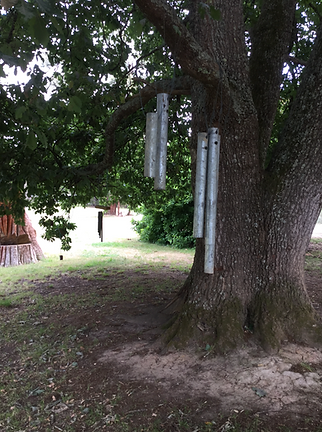




The students at Forrest Primary School have been encouraged to build their own musical instruments out of materials. It is easy to imagine a music or dance lesson being held in this setting.
This could also be a designated classroom for creative writing, reading or circle time.

This learning space can be utilised in many ways, however its primary function is a fire pit. Students sit down on the logs that have been carefully placed in a circle and together the students and teachers build a fire. Recently, they cooked sausages as if they were camping. Kim stated that ‘some students do not get to experience camping so we thought we could bring the experience to them’.
While cooking sausages is great fun and teaches students ‘life skills’, it also has the potential to cover curriculum standards. Some discussed learning opportunities for the younger years included:
Literacy (level two)
Creating texts
Create short imaginative, informative and persuasive texts using growing knowledge of text structures and language features for familiar and some less familiar audiences, selecting print and multimodal elements appropriate to the audience and purpose (VCELY230) (AusVELS, 2015).
Number and Algebra (level two)
Fractions and decimals
Recognise and interpret common uses of halves, quarters and eighths of shapes and collections (ACMNA033)
'KIDS GO BUSH' PROGRAM: PRE-SCHOOL - GRADE TWO.

Every Friday morning pre-school to grade two students participate in the ‘Kids go bush’ program held within the school grounds. Kim Coulter stated that “The students absolutely love the program, parents have reported that they do not even have to try to get their kids out of bed on a Friday morning. Parents find their kids already awake and waiting to get ready for school because they are so excited for ‘Kids go bush’”.
Every student packs a change of clothes and wears gumboots to school. They dress appropriately for the weather. The rain during winter does not deter the children from being outside unless it becomes too heavy and all students and staff move inside for shelter.
The program allows students to have free play with little adult intervention. The students are carefully supervised but are encouraged to problem solve, create and investigate on their own accord. The students build cubby houses using mainly natural materials and tools, play in the mud pit and learn to climb trees to a certain height. This program is not simply ‘free time’. It is built into the curriculum as students learn fundamental skills during this lesson. Anecdotal evidence collected by observing teachers shows that students:
- Collaborate by designing and building new structures in groups
- Help each other by explaining and modelling how to climb a tree. Students are not allowed to physically pull or support another student when tree climbing.
- Encourage each other. Students have been seen to clap and cheer when their classmate achieved something they had been working towards, such as climbing to the first branch on a tree.
- Problem Solve by moving objects that can enable them to reach branches to climb or materials needed for building their structure.
These experiences can be and are translated back into the indoor classroom. Forrest Primary School is working hard to create a seamless transition between inside and outside learning.
Forrest Primary School also have a gardening program for the grade three to grade six students. The school can see a potential for creating a communality ownership in the future. They wish to reach out to the broader community in order to promote and share their special space.